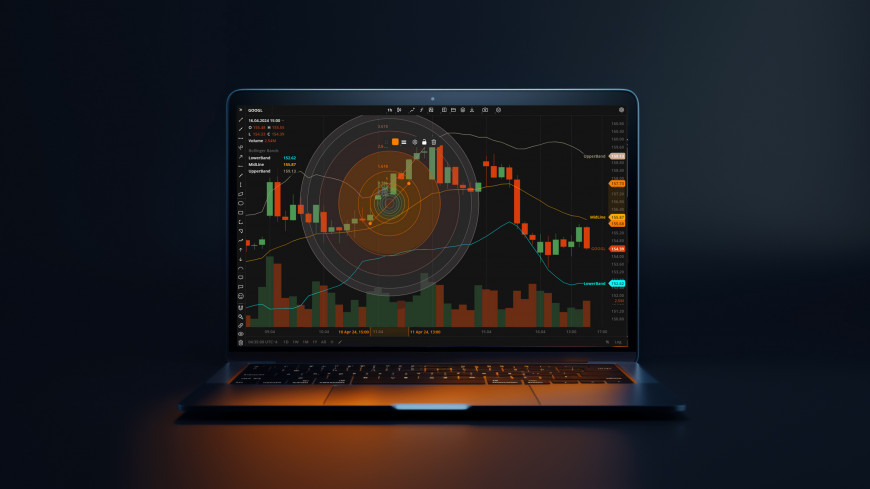Licensing a Charting Library: How to Retain Control Over Client Data

The brokerage space is far from a niche industry, with thousands of firms vying to provide the best service in a battle for client retention. The cost per click (CPC) in digital ads can reach $100 and higher. A survey conducted by Devexperts indicated a potential 58% churn rate in scenarios where clients are presented with a better platform. This gives us a sense of just how costly client acquisition can be.
One way to increase retention is by providing users with a unified platform/app experience, where application boundaries are indistinct, allowing users to focus on their tasks rather than the tools. This also eliminates the number of points where the user might come into contact with other vendors on their workspace.
Imagine a retail trader’s workstation: a typical desktop set-up includes a myriad of analytics tools, news monitoring apps, social media and messaging apps, and tools for managing their portfolio. When these are all provided by different vendors, the sources for client data sharing are increased. This imposes a problem of obtaining their contact details and approaching them to switch fully to the supporting app, rather than using it as an integrated part.
We see that many news websites, similar to Yahoo Finance, Benzinga, or Investing.com, place charting widgets on their websites to allow visitors to conduct high-level analysis right there with the news feed on the side. This offers a better experience, but what if the website owners don’t have control over their financial charting software and have to keep a vendor’s logo in the bottom corner? They have opened themselves up to the threat of losing customers.
In this article, we explore how DXcharts, a financial charting library and widget, provides a higher level of control over other market data visualization offerings on the market for banks and brokers.
Client data ownership
As it stands, some major financial chart solutions are designed so that licensees (investment banks and brokerage firms) do not have control over sharing their users’ activity and contact data with the vendor platform.
When the charting vendor requires the brokers’ or banks’ clients to also log in on their website, the bank or broker is in a situation when they are not the only owner of the user contacts. This creates a risk of some user data or actions leaking to 3rd party providers.
An example here can be a charting provider who became a marketplace of brokers and a social network where retail traders communicate. Now this provider’s subscribers can easily switch from one broker to another without the need to install a new platform or adapt to to a new interface.
As a result, businesses can lose the client, or partial revenue from this client. This also suffocates their ability to retrieve insights and leverage them to improve and tailor their services to their user’s needs.
3rd party vendor logo-free interface
Branded links and labels across a licensed interface mean the financial firm and their vendor are constantly competing to retain their end users.
DXcharts can be completely customized with independent branding, free of any clickable reference to DXcharts.
Existing UX/UI elements can be changed, and new elements can be created to provide a totally unique experience, tailored to the behaviors and needs of the brokers’ user base.
Software limitations
Another retention-related risk that firms face on non-exclusive platforms, is operating within the limitations of their service offerings.
They are not able to adapt to user scenarios beyond what the vendor offers, leading to their clients seeking out another provider who can.
Level of service
Brokers with experience can attest to the importance of vendor customer service – and equally, the traditional lack of it.
Licensees of DXcharts receive access to technical advisory and product support. They also provide an in-depth onboarding phase, with engineers who are specialized in financial markets, on hand to help smoothly embed the charting library.
The solution?
To avoid these retention and stagnation risks, and secure exclusive ownership of client data, banks and brokers have two options: develop their own charting library in-house or license from a trusted vendor.
Developing a solution in-house has obvious drawbacks: time to market, resources, expertise, and costs required. For most firms, option 2 is the most practical and efficient path.
Why do industry-leading names choose DXcharts as a vendor?
Flexibility: A charting tool that is white labeled with the firm’s brand only (no DXcharts logos or links).
Client data ownership: Banks and brokers have exclusive control over client data.
Performance: Super fast with advanced charting capabilities. Interactive charts stay responsive and nimble even with thousands of bars, hundreds of drawings, and dozens of indicators.
Source code opportunity: DXcharts allows firms to purchase the source code if they wish.
Support: Maintenance and responsive customer support are part of the deal. The same developers who created the charting library can also help integrate it into your app.
Join the growing number of stock trading firms who are realizing that brand exclusivity, customization flexibility, and control of client data, are non-negotiable for optimal growth, retention, and revenue.